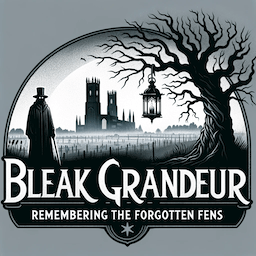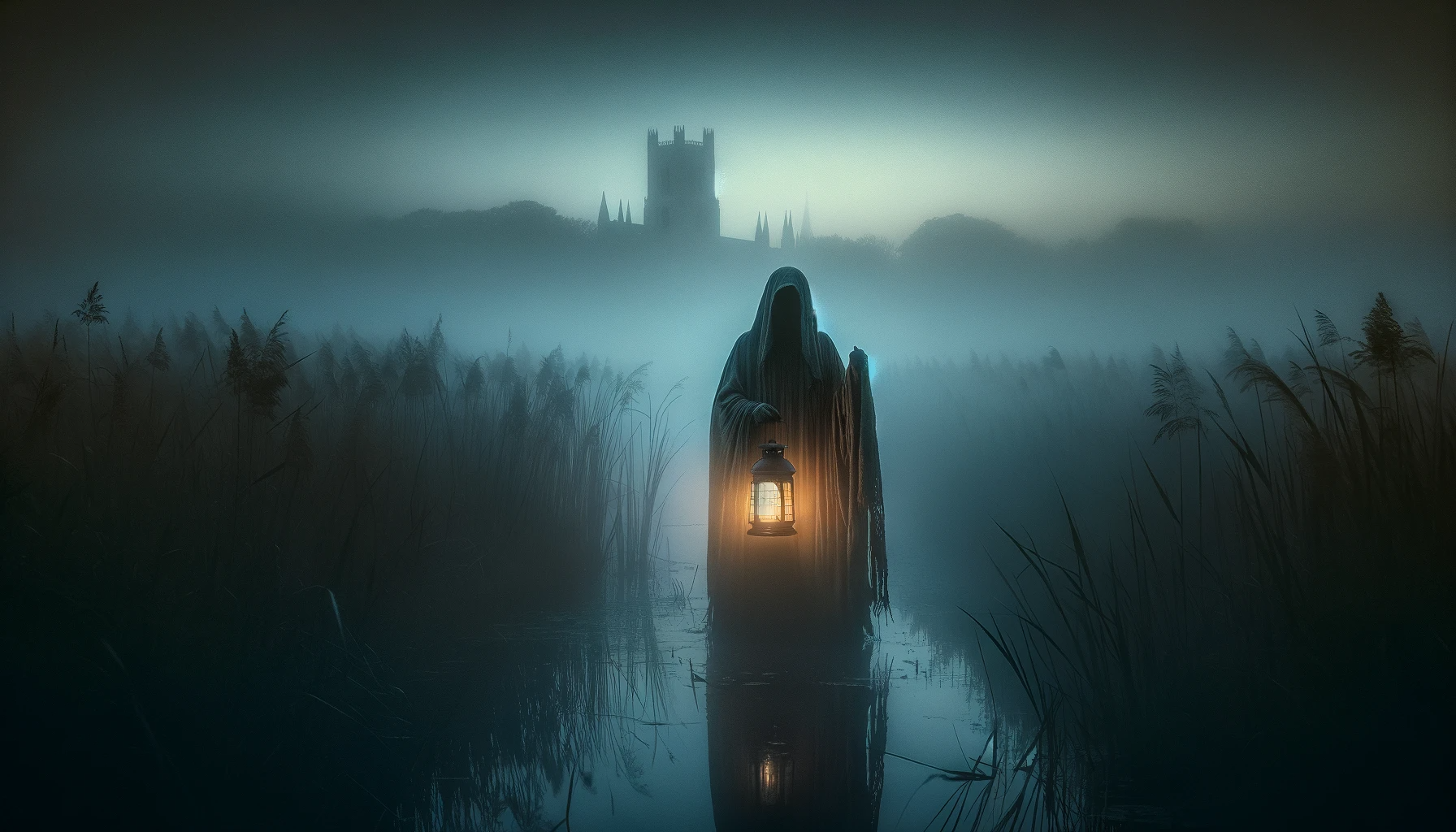The Lantern Men of the Fens are a captivating subject indeed. The interplay of folklore, history, and the unique psychogeography of the Fens, particularly around Ely and its environs, is fascinating.
The Fens, a vast expanse of marshland in eastern England, have a rich and often eerie history. Its flat, open expanses, waterways, and often mist-laden atmosphere have given rise to numerous tales and legends, of which the Lantern Men are a particularly evocative example.
Historical and Folkloric Background:
The history of the Lantern Men is intertwined with the broader history of the Fens. Before extensive drainage projects in the 17th century and later, this region was a labyrinth of waterways, marshes, and islands.
The Lantern Men, or Will-o’-the-Wisps, are part of a broader European folklore but have a particular resonance in the Fenlands due to the unique topography.
Historically, these tales likely served as cautionary fables. The Fens were dangerous, especially at night, and stories of malevolent, misleading spirits would discourage people from venturing into these treacherous areas after dark.
The phenomenon that likely inspired these tales—spontaneous ignition of marsh gases or bioluminescent organisms—would have been a common sight in the undrained marshlands, lending credibility to these stories.
Social Impact and Psychogeographic Aspects:
The Fens have always been isolated from the rest of England, both geographically and culturally. This isolation has fostered a unique social environment where local legends and folklore, like that of the Lantern Men, have flourished. These tales are not just stories; they are part of the people’s collective identity in the Fens.
Psychogeographically, the Fens present a landscape that is both haunting and beautiful. The vast, open skies and the flat land stretching to the horizon can induce feelings of freedom and unease. The Lantern Men, in this context, are not just supernatural entities but are also reflections of the landscape itself—mysterious, elusive, and potentially dangerous.
Spiritual and Religious Implications:
The spiritual landscape of the Fens is as complex as its physical one. The dominance of Ely Cathedral in the region is a testament to the strong Christian influence. However, the Fens have also been where older beliefs and superstitions have persisted. The Lantern Men can be seen as a remnant of these older beliefs, a folkloric expression of the mysteries of nature and the unknown.
In a region that has often been physically and culturally isolated, these tales also offer a spiritual exploration of the unknown. They represent the human attempt to make sense of and find meaning in the natural world, particularly in a landscape as enigmatic as the Fens. The Lantern Men, in this sense, bridge the gap between the natural and the supernatural, the known and the unknown, the material and the spiritual.
The Lantern Men of the Fens are a rich tapestry of history, folklore, social identity, and spiritual exploration. They are a product of the unique landscape of the Fens and have, in turn, helped shape the cultural and spiritual essence of the region.
The nature of the Fen Lantern Men, whether a force of good or evil, is open to interpretation and subjective perception. The Lantern Men are often portrayed as mischievous or evil spirits in folklore, leading travellers astray in the treacherous marshlands. Their deceptive nature and association with danger can be seen as negative traits.
However, it is vital to consider the cultural and historical context in which these tales originated. The stories of the Lantern Men served as cautionary fables, warning people of the hazards of the Fens and discouraging them from venturing into dangerous areas after dark. From this perspective, the Lantern Men can be seen as protective figures, guiding people away from harm and ensuring their safety.
The Fens haunting beauty and enigmatic atmosphere also evoke a sense of freedom and unease. The Lantern Men, as part of this melancholic yet breathing landscape, reflect this duality. They embody the mysterious and potentially dangerous aspects of the Fens, but they also represent the allure and fascination of the region.
Ultimately, whether they are considered a force of good or evil may depend on individual beliefs, interpretations, and personal experiences. They can be seen as embodying light and darkness, and their significance may vary depending on the context in which they are encountered.
It is worth noting that folklore often reflects a society’s fears, hopes, and values. The portrayal of the Lantern Men as good or evil may also reflect the cultural attitudes and perceptions of those who tell these stories.
Contemporary Relevance:
The modern relevance of the Lantern Men, and folklore like it, in the Fenlands and beyond, is multifaceted. In an age where scientific understanding has demystified many natural phenomena, one might assume such legends would fade into obscurity. However, these tales continue to hold significance in several ways:
- Cultural Heritage and Identity: In the Fens, as in many other places, folklore forms a crucial part of cultural heritage. The stories of the Lantern Men are a link to the past, connecting current generations with their ancestors. They offer a sense of continuity and identity, particularly in a rapidly changing and increasingly globalized world. Celebrating these stories can be a way of preserving and honouring local history and traditions.
- Environmental Awareness: The Lantern Men are deeply connected to the natural environment of the Fens. In a modern context, these stories can be repurposed to foster ecological awareness. They can be used to highlight the importance of preserving unique landscapes like the Fens, emphasizing the need for environmental conservation and respect for natural habitats.
- Psychological and Sociological Insight: Folklore often reflects the fears, hopes, and values of the society from which it originates. The stories of the Lantern Men, with their themes of danger, mystery, and the unknown, can provide insights into the historical psyche of the Fenland inhabitants. In a modern context, they can prompt reflection on how our perceptions of nature and the supernatural have evolved.
- Artistic and Literary Inspiration: Folklore is a rich source of inspiration for artists, writers, and creators across various mediums. The eerie and evocative imagery associated with the Lantern Men can spark creativity, leading to works of art, literature, and media that reinterpret these legends for a contemporary audience.
- Educational Value: These stories can be used as educational tools, offering a way to engage people, particularly children, in the history and geography of their local area. They can be a starting point for discussions about folklore, history, natural sciences, and environmental studies.
- Community Building: Folklore like that of the Lantern Men can also play a role in community building. Festivals, storytelling events, and other community activities centred around these tales can strengthen social bonds and foster a sense of community pride and togetherness.
The Lantern Men of the Fens and the Lantern at Ely Cathedral share intriguing parallels. Both symbolic entities evoke a sense of mystery and illumination in the Fens.
The Lantern Men, as folklore entities, are often associated with mischievousness and danger, guiding travellers astray in the treacherous marshlands. On the other hand, the lantern at Ely Cathedral serves as a literal and metaphorical beacon of light, guiding and welcoming people to the spiritual sanctuary of the cathedral.
While the Lantern Men embody the enigmatic and potentially dangerous aspects of the Fens, the lantern at Ely Cathedral represents a more positive and protective role. It acts as a guiding light, providing a sense of safety and a focal point for navigation in the vast, mist-laden landscape.
Moreover, both the Lantern Men and the lantern at Ely Cathedral carry cultural and historical significance. The Lantern Men are deeply rooted in the folklore and identity of the area, reflecting the fears and cautionary tales of the local community. Similarly, the lantern at Ely Cathedral is an iconic symbol of the region, representing centuries of religious devotion and architectural grandeur.
The parallels between these two entities extend beyond their symbolic nature. They both exist within the same physical and cultural landscape, intertwining with the unique psychogeography of the Fens. The isolation and haunting beauty of the Fens have shaped the narratives surrounding the Lantern Men and provided a backdrop for the prominence of Ely Cathedral.
In conclusion, while the Lantern Men of the Fens may originate from a long past, their relevance persists in various forms. They continue enriching cultural heritage, inspiring creativity, educating, and contributing to local economies and environmental awareness. These stories, transcending their origins, have become timeless, evolving in meaning and significance in the modern world.
While rooted in the past, these tales continue to resonate, reminding us of the enduring power of folklore and the deep connection between people and the landscapes they inhabit.

